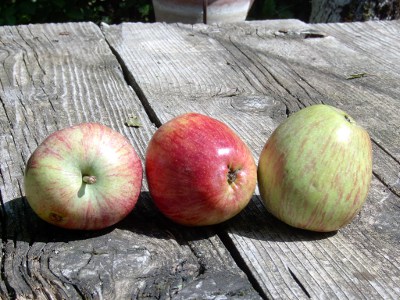︎︎︎ MELA RIGHETTA

Le piante madri sono state ritrovate nel comune di Pieve S. Stefano (AR). Non se ne conosce l’origine, ma veniva coltivata in queste zone di alta collina dove era molto conosciuta. Se ne trovano ancora poche piante sparse abbandonate. L’albero è mediamente vigoroso, di forma irregolare. E’ molto rustico e resistente a condizioni di bassa fertilità; alterna la produzione. Il frutto è di dimensioni medio-grandi; di forma conica appuntita. La buccia è di colore verde con striature regolari rosse su tutto il frutto, privo di lenticelle; il peduncolo è lungo e non spesso, inserito in una cavità aperta poco profonda, la cavità calicina è quasi inesistente. La polpa è bianca, croccante, acidula, molto profumata e succosa. Viene raccolta ben asciutta dalla rugiada la prima decade di ottobre, con la luna calante o ‘dura’, come si diceva una volta, e si serba egregiamente in fruttaio. Si comincia a consumare a novembre. Ottima mela da consumo fresco e da cottura, prende il nome dalle striature molto evidenti della buccia. Se ne può far crostata e gelatina, ma tradizionalmente veniva cotta al forno con un cucchiaio di zucchero sopra ad ogni mela e un bicchiere di vino bianco nella teglia.
The mother plants were recovered in the area of Pieve Santo Stefano (Arezzo). Its origin is unknown but it was cultivated in these high hills where it was very common. A few individual, scattered and neglected trees can still be found. The tree is moderately vigorous, irregular in shape. It is very hardy and resistant to low fertility conditions; it crops on alternate years. The fruit is medium-large in size, with a pointy, conical shape. The stem is long and not thick, inserted in an open and not too deep cavity. The calyx is almost absent. The skin is green in colour with regular red streaks over the entire fruit and it has no lenticels. The flesh is white, crisp, slightly sour, very aromatic and juicy. It is harvested once well dry from the dew in the first ten days of October and with waning or “hard” moon, as it once was called. It stores very well in the fruit-house. It can be eaten starting in November. It is a wonderful apple for fresh eating or cooking. It takes its name from the very marked streaks on its skin. It is used to make crostata (fruit pie) and jelly but it was traditionally enjoyed baked in the oven, with a tablespoonful of sugar over each apple and a glass of white wine in the baking pan.